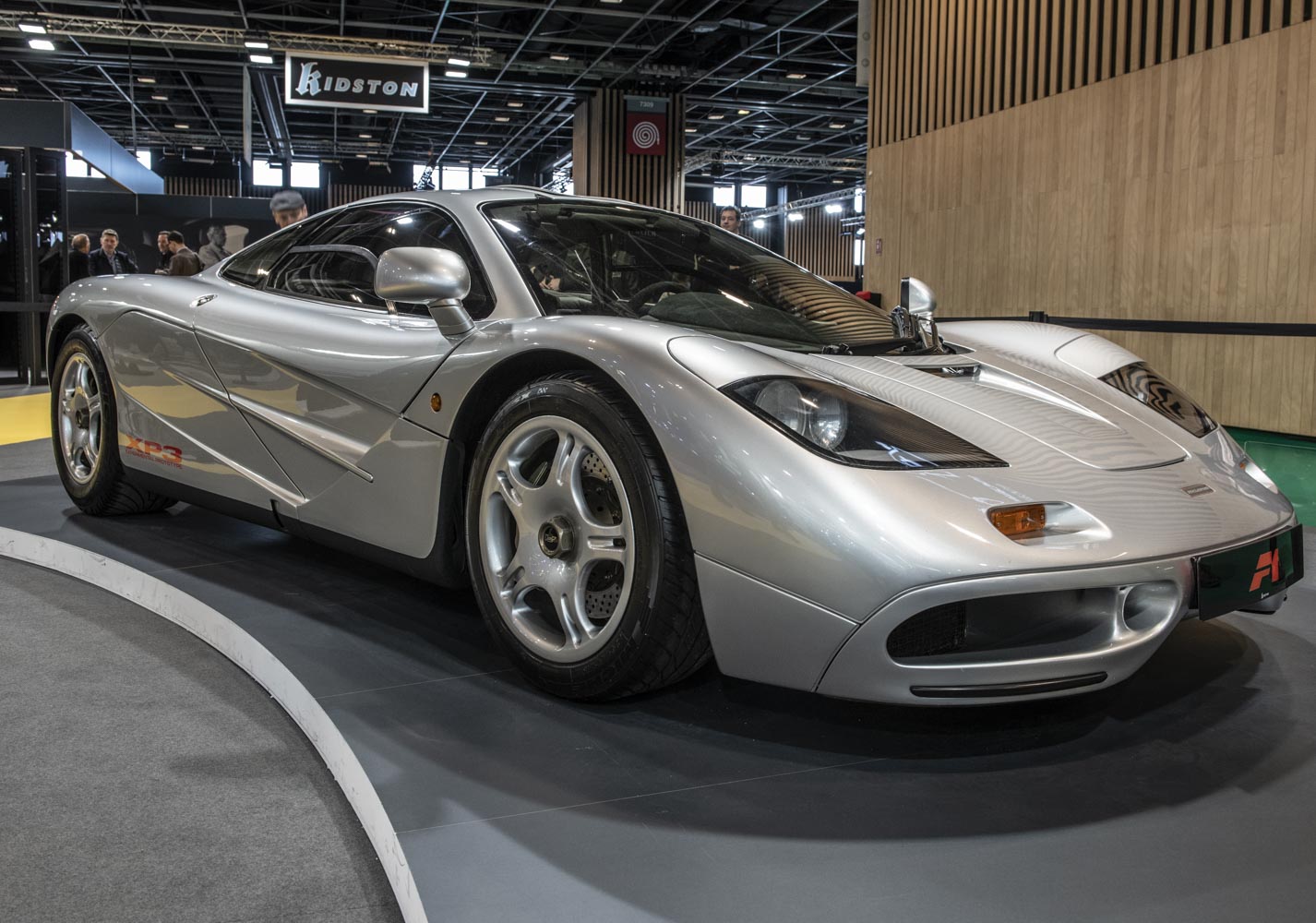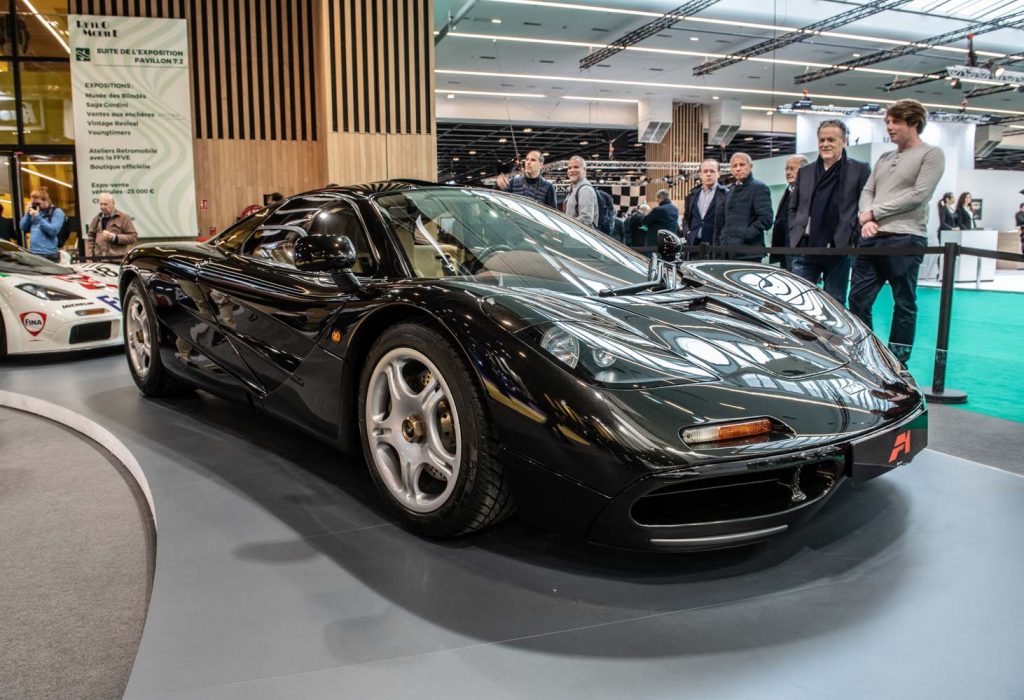
Mclaren and Rétromobile: they are a fixture at Paris Expo every year. Clockmaker Richard Mille had already surprised us several times in previous years with beautiful Mclaren cars on his equally beautiful stand. Through his direct line with Woking, as sponsor of their F1 team, he managed to get Mclaren to bring part of its collection to Rétromobile. You can read a post from this expo here.
KIDSTON
Richard Mille was sadly not there this year. In charge, at the FIA, of the prototype races of the WEC, he was in Sebring for the opening round of the championship. Fortunately, there was a back-up from Switzerland, and what a back-up: dealer Simon Kidston had brought seven examples of the Mclaren F1 to Paris, kicking off the 30th anniversary celebrations of this supercar. And seven units out of 106 is certainly not bad. Mclaren built 69 units of the “regular” F1 and 6 of the F1 LM. This was a model fitted with the bodywork of the GTR racing car as a reminder of its victory in the 24 hours of Le Mans. A further 3 F1 GT or “Longtails” were then produced. Besides the street cars, 28 F1 GTR racing cars were also built. Adding all this up, we arrive at 106. And “106 Drivers club” is immediately also the name of the very exclusive club that brings together the owners of this model, at regular intervals, for an outing with their F1.
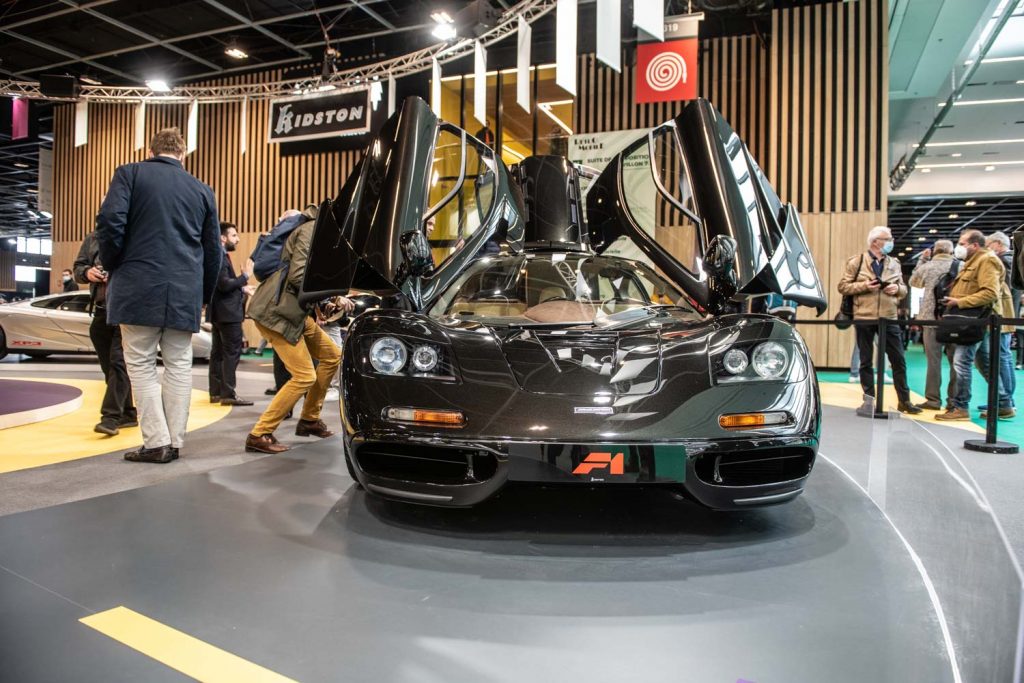
Actually, it was only six F1s because one of the five XP prototypes built was also present. And the latter are not recorded in the official chassis number register. But don’t let this spoil the fun.
XP 3
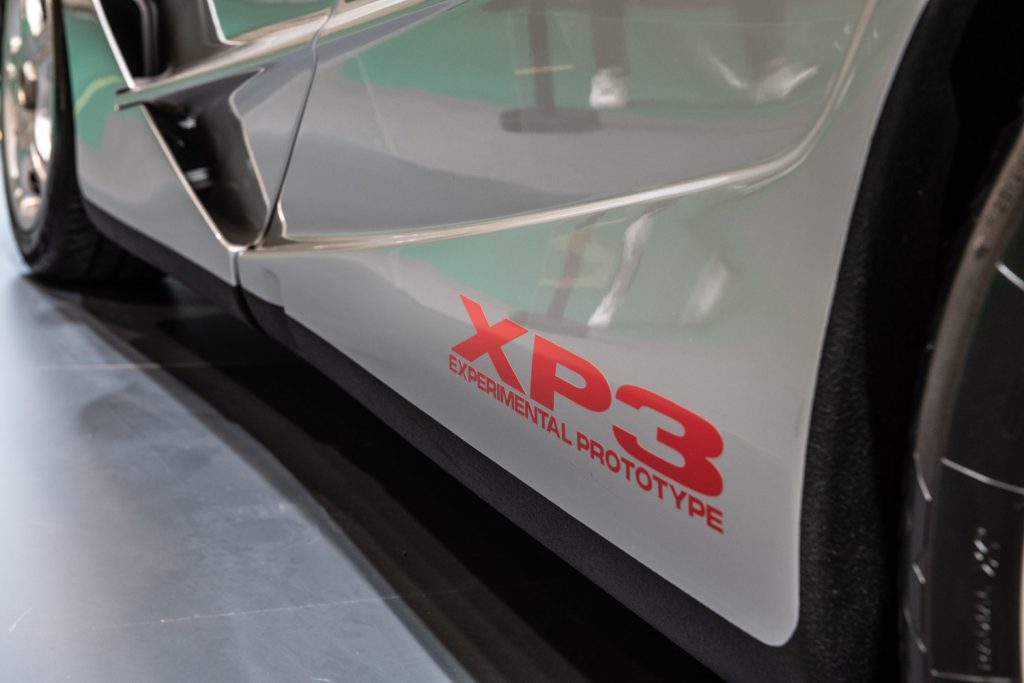
We begin our review with the oldest rascal of the bunch: the XP 3. XP stands for “Experimental Prototype”. These are prototypes that only serve as development for the final production cars. With a normal brand, these are pushed into the scrapper after proven service but you don’t really do this with a Mclaren F1.
Although this was the case with XP1 anyway. XP1 was the first driving prototype to complete its first laps on the Silverstone circuit just before Christmas 1992. Meanwhile, Mclaren was building the next XPs. All had a specific purpose in an extensive test programme laid out by Gordon Murray. XP 2, for instance, was used for the obligatory crash test. Something that might have seemed unnecessary after an incident with XP 1.
After being used at Mclaren for several months, XP 1 moved from Woking to Munich. BMW Motorsport engineers needed the prototype to carry out various cold and heat tests. So XP 1, packed with diagnostic equipment, arrived in the Namibian desert on 17 March 1993. Five days later, a BMW engineer hit a rock at high speed. XP 1 shoots into the air and absorbs several heavy blows. The driver is only injured by the flying computer equipment and is able to exit XP 1 along the open windscreen. Talk about a test. Unfortunately, oil spills onto the blood-hot exhaust and some smoke develops. A small fire becomes a big one and, due to lack of extinguishers, XP 1 burns up completely in the Namibian desert. Ron Dennis had all the parts stored in a large crate and buried next to the factory.
Two days later, XP 2 was ready. After the first test runs, it also left for BMW for their further test work and then returned to Woking. There, preparations were started for the official crash test at Mira. The carbon structure of the F1 was so strong that, after the test at 30 miles per hour, XP 2 was still able to drive off under its own power. XP2 will not be used any further.
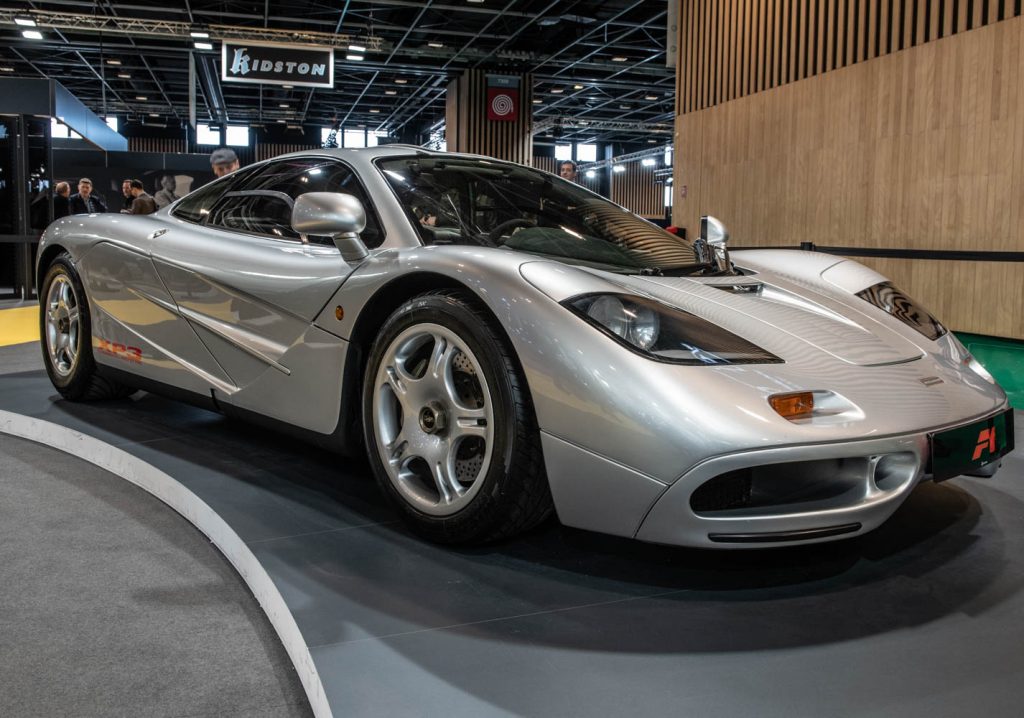
XP3 is of course next in line and this silver grey F1 makes its debut at the 1993 British Grand Prix. XP3 will become the most widely used F1 and will later become best known as Gordon Murray’s personal car with the number plate K 50 BAT. Murray would drive around in it for many years. But first XP3 was used for a very heavy testing programme. Ron Dennis even added Formula 1 drivers Mika Hakkinen and Jonathan Palmer to the test team. XP3 will be heavily used and at that time, until the arrival of XP4, will be the only driving one. This next XP copy will also allow the start of high-speed testing. Then follows, as the last XP, number 5 with number plate K8 MCL. This dark green F1 will later become world-famous as a demonstration and test car. It ends up in all car magazines and makes its debut in the TV programme Top Gear. Presenter Tiff Needell is wildly enthusiastic. XP5 remains the property of Mclaren after its media career and enters the “Heritage collection”. In March 1998, XP5 makes another appearance and sets a new speed record at Volkswagen’s test track in Ehra-Lessien. Andy Wallace achieves a top speed of 386.7 km per hour. This record will stand until 2007. The Bugatti Veyron then breaks the 400 km/h mark. To do so, Bugatti did use an engine, equipped with 4 turbos, which delivered 400 HP more power. To this day, the Mclaren F1 remains the fastest series car with an atmospheric engine. Only the Murray T50 could still be a threat for another record attempt. You can read more about XP5 here.
007 en 053
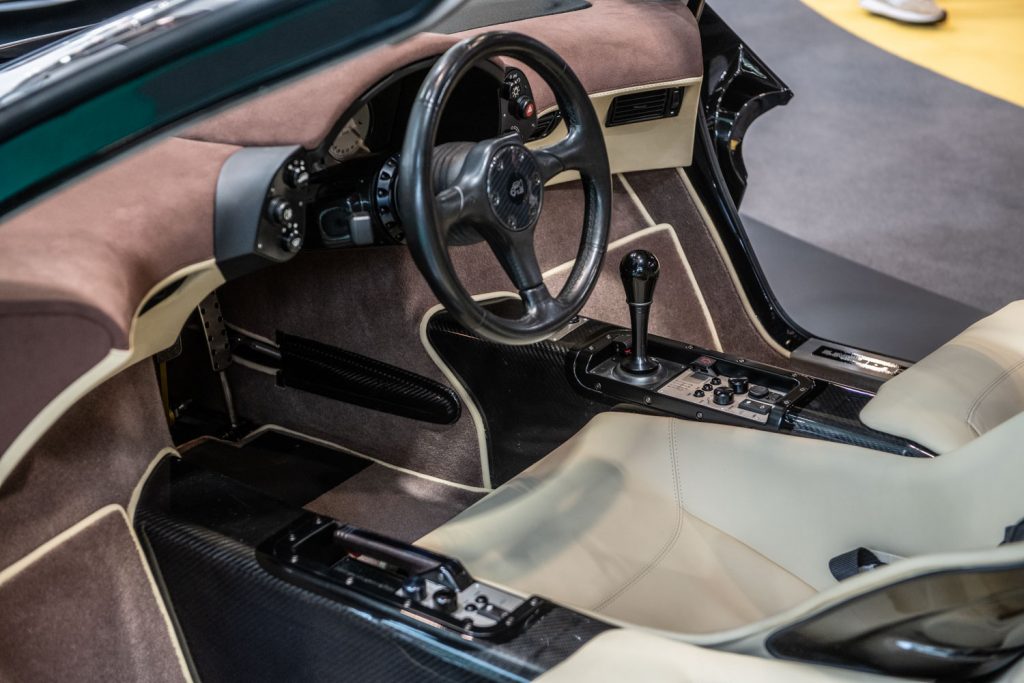
After the XP period, Mclaren began series production of the F1. With chassis number 007, we find a series version created in early 1994 in Jet Black colour.
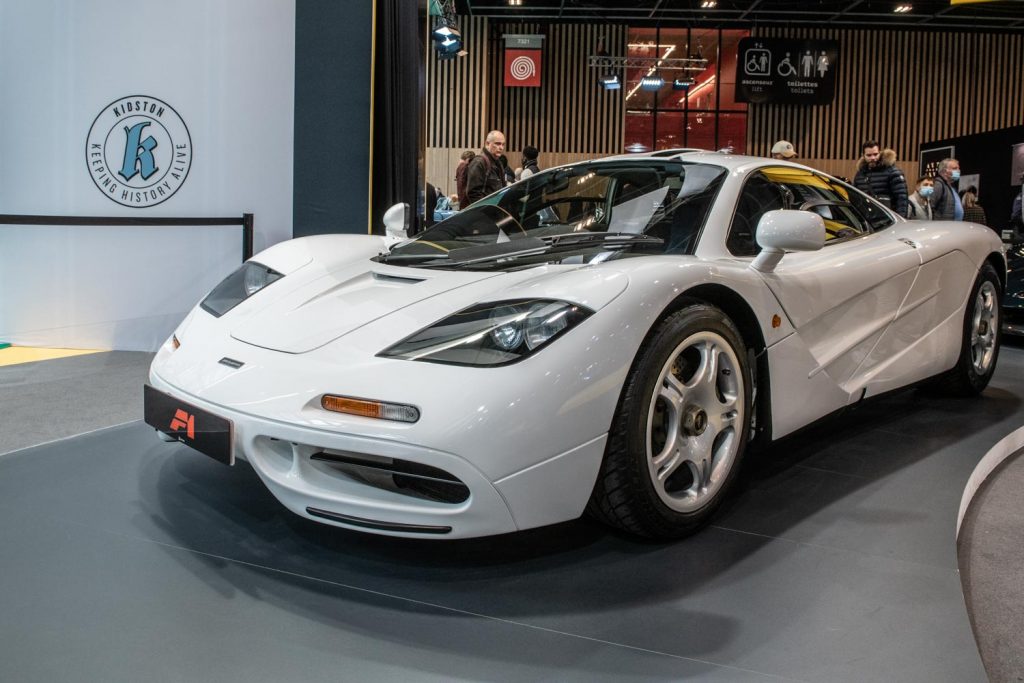
Chassis number 53 was delivered to its owner in Marlboro white in late 1995. Both cars regularly stood with the doors and bonnet open. We will let you enjoy these exceptional moments. Be sure to admire the Spartan interior and beautiful V12 BMW engine with the gold heat plates.
016 R
Although it was not originally envisaged, Mclaren also moves to the racetrack with the F1. Ray Bellm and Thomas Bscher convince Ron Dennis to create a racing version of the F1. Gordon Murray designs the F1 GTR for this purpose. You can read more about this in an earlier article on the F1 GTR.
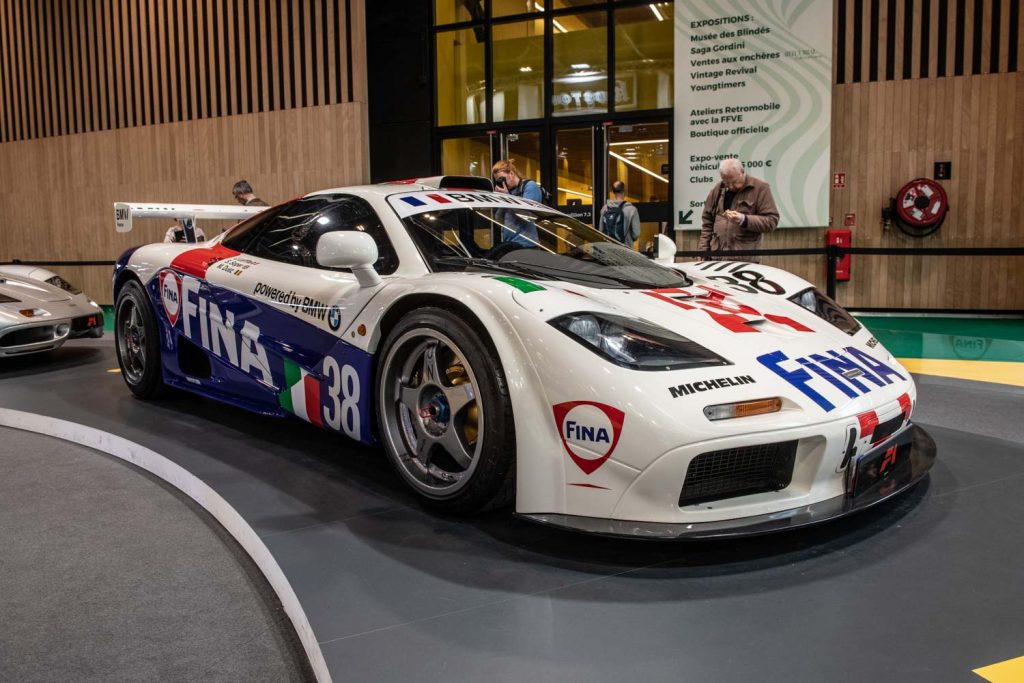
After Mclaren’s victory in the 1995 24 Hours of Le Mans, Munich-based BMW also started itching to launch a GT programme for Le Mans participation. With the financial support of oil company FINA, an official BMW team was set up. Italy’s Bigazzi would be responsible for running the F1s and was given 3 units ( 016R-017R and 018R ) to do so. BMW USA funded the participation of 017R while 016R received support from BMW UK and France, while 018R was the test and reserve car. Pilots on duty on 016R: Steve Soper,( UK ) Jacques Laffite (France ) and Marc Duez ( Fina ).
016R will only make two appearances on the race track. In preparation for the 24 hours of Le Mans, the Bigazzi team will start in the BPR race at Silverstone, with 016R finishing in 11th place. The colleagues in 017R start from pole position but, due to a fuel shortage, fall just short of the podium with fourth place. The race is won by the Harrods Mclaren of Grouillard and Wallace.
Things are not exactly going well for Mclaren in the 24 hours of Le Mans. Clutch problems caused all the Mclaren cars to lose more than one hour of time to fit new parts. Notwithstanding these inconveniences, all Mclaren’s finish in the top 10 of the race in places 4-5-6-8 and 9. Only 016R falls just outside this top 10 with place 11. And with two 11th places, its active racing career also ends and 016R gets a new owner. In 2002, Mclaren specialist Lanzante rebuilds 016R from course to track version ( with official public road registration – number plate N276 JKB ) in Papaya Orange. Thirteen years later, the next owner, also at Lanzante, will have just the opposite done, with 016R reappearing in its original Le Mans livery but retaining its track registration.
An identical example also exists today in the BMW Classic collection in Munich. This is chassis number 018R ( the test car ) which received an original spare bodywork of 016R. 017R is still owned by BMW USA today and is in their historic motorsport collection, 100% original.
056 XP GT
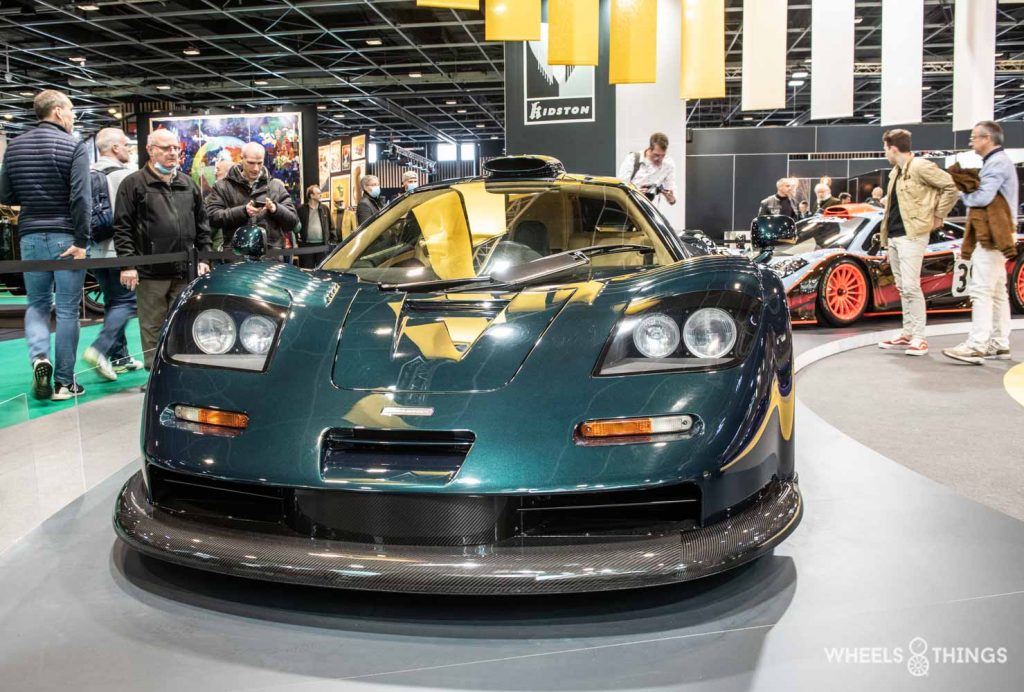
After the arrival of the Porsche 911GT1 in 1996, Mclaren had to respond with an evolution version of the F1. You can read all about this in our article on the year 1997 and the combination of Mclaren and Schnitzer. The F1 was fitted with a “longtail” bodywork and also received several mechanical modifications. For instance, the manual gearbox was replaced from now on by an X-trac sequential version and the BMW V12 engine and brakes were also taken in hand.
To use this car in races, there obviously had to be a track version of it. Gordon Murray didn’t really like the F1 GT ( without the R ). And in this he was absolutely right, because the street version of the F1 GTR looks much better. In the race version ( with the big rear wing ) it was not so bad. The 056 XP GT shown at Rétromobile is the prototype where all these innovations were tested before the street version. Chassis 019R was used to develop the race car. This F1 painted in Silverstone green is certainly not the prettiest. The green metallic colour doesn’t really help that either but, with three examples built, the F1 GT remains a very unique car in Mclaren history.
025R
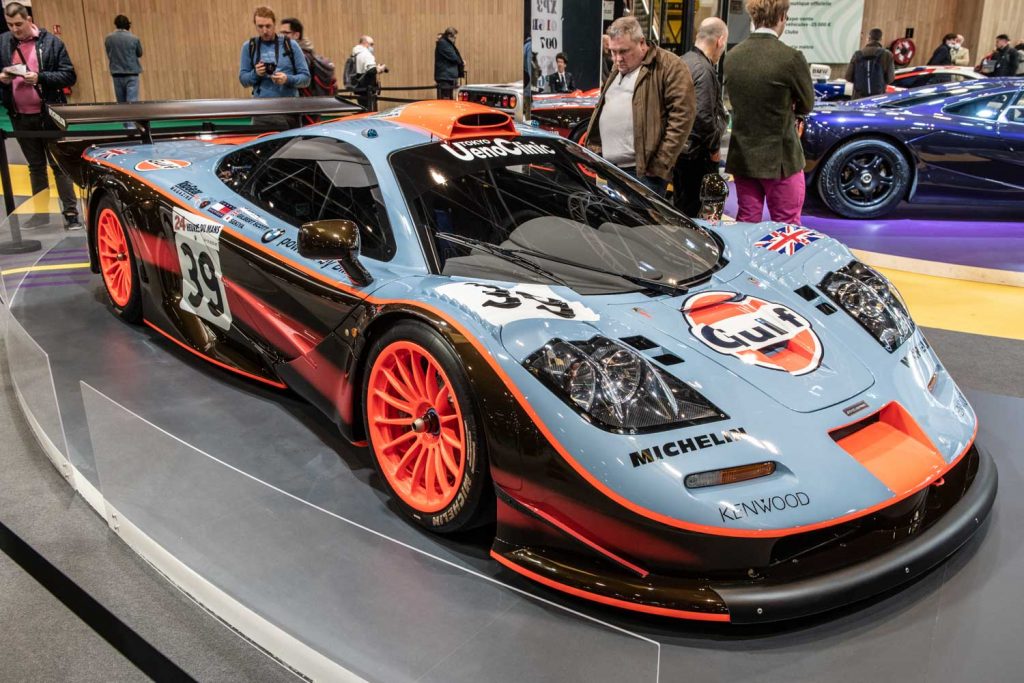
Gulf and the Mclaren F1 are two concepts that were linked for three years. After the successful BPR years of 1995 and 1996, a go-ahead is given for 1997 in the FIA GT championship. The two competing Mclaren teams of Dave Price and Michael Caine’s GTC are merged to form the Gulf Davidoff Team. They order three examples of the new F1 GTR Longtail. Chassis numbers 020R – 022R and 025R are delivered to the team by Mclaren. The Gulf blue changes from dark to light blue. After the 24 hours of Le Mans, 024R ( the Schnitzer of Letho-Piquet and Soper ) also joins the ranks to replace the burnt chassis 022R, which had to be rebuilt after the Le Mans race following a fierce fire in qualifying.
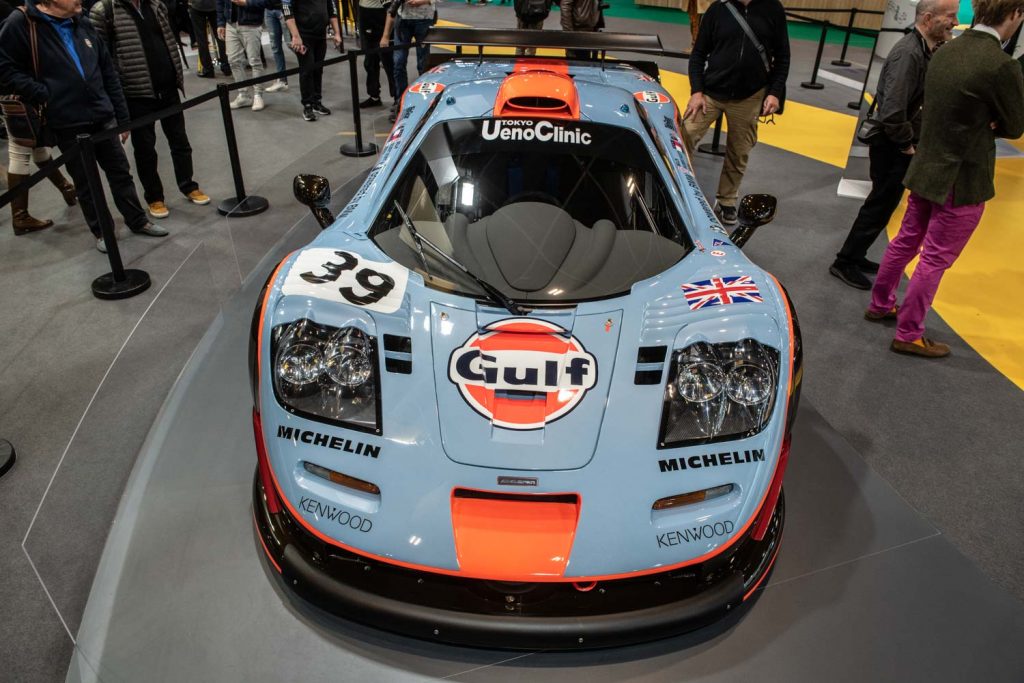
025R is the F1 GTR Longtail with the highest number of participations in races. After the FIA GT Championship and the 1997 24 Hours of Le Mans ( abandonment after another fire ), 025R leaves for the Far East and enters the All Japan GT Championship from 1999. Hitotsuyama Racing will run it until 2005. 025R will fight 37 races in seven years. No other chassis even comes close to this number.
After its Japanese career, 025R ends up in Europe again, with a subsequent owner. This one sends his new purchase to Woking to have it restored to its original 1997 condition by the Mclaren Special Operations department. In its seven-year racing career, 025R had obviously undergone a number of modifications and updates and all of these had to be removed back. New original 1997 parts will be used for this purpose. 025R then leaves for “F1 specialist” Paul Lanzante for a modification on public roads. Yes, in the UK this is the most normal thing in the world that an ex Le Mans GT1 competitor from Porsche or Mclaren can just participate in traffic on public roads. He gets number plate P404 RCR. So why can’t this be done here?
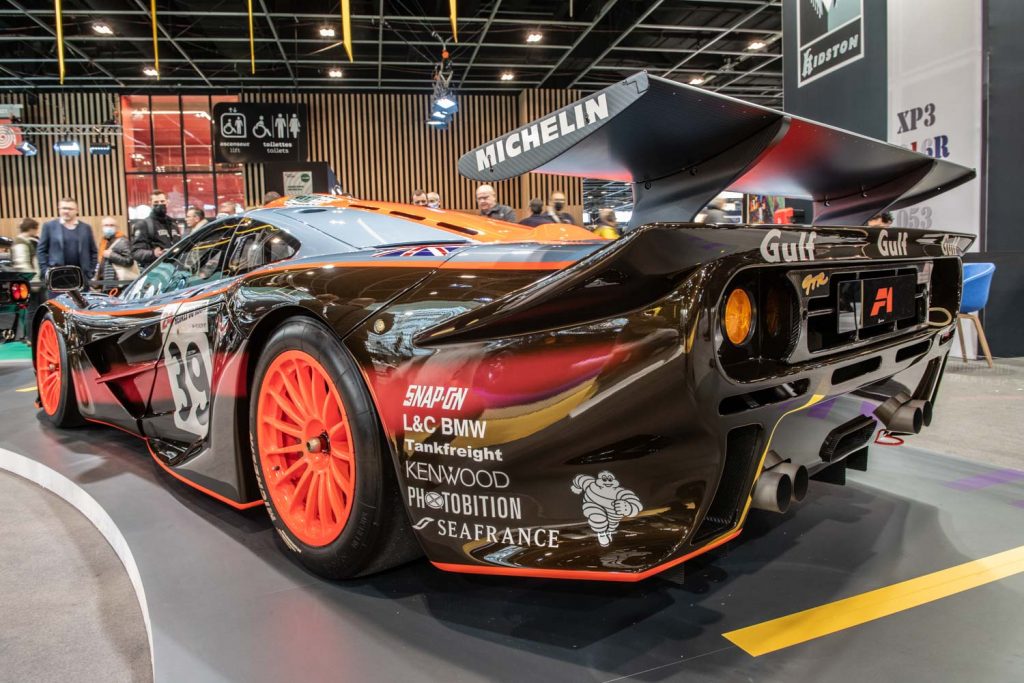
After just under two years of work, the “revamped” 025R will be presented at the prestigious 2018 Hampton Court Concours near London. Mclaren Special Operations is thus delivering its calling card of their ability. Cost? We really don’t want to know.
025 – George Harrison
The Mclaren F1 was obviously coveted by very famous people who were happy to pay a million dollars for it in 1993. Among them current Tesla boss Elon Musk ( he had good taste then after all ), Rowan “Mister Bean” Atkinson, fashion designer Ralph Lauren and George Harrison. This ex Beattle ordered an F1 finished in dark purple, which was delivered in mid-1994 and given chassis number 025.
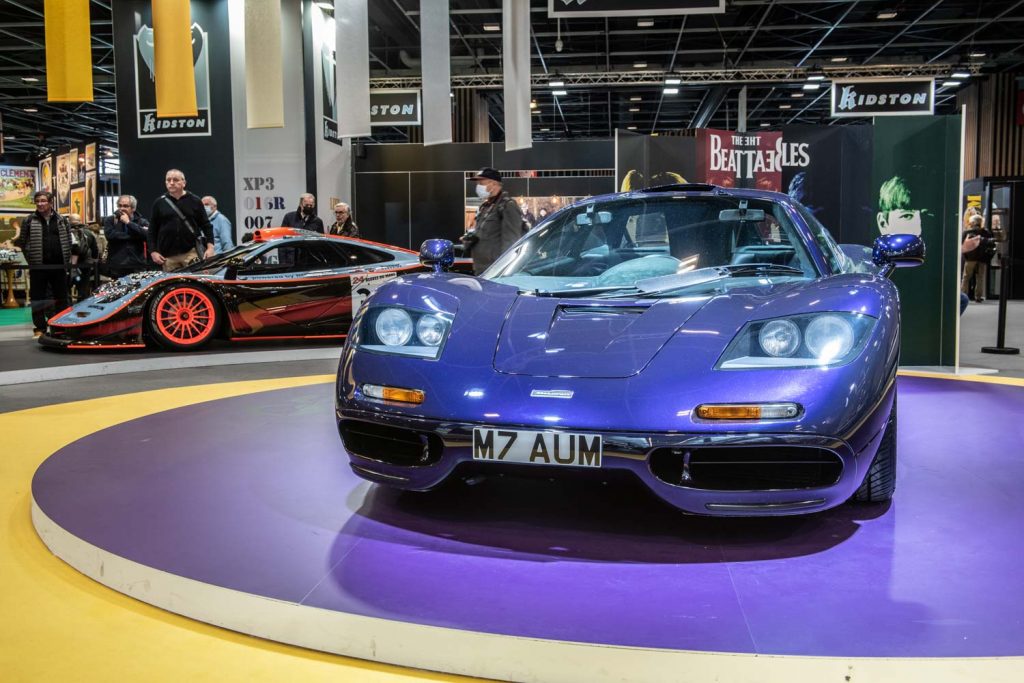
This 025 took centre stage at the stand. According to organiser Kidston, 025 was the star of the expo. On the face of it, a fairly normal F1 so what makes it special? In this case, it’s not really the car but obviously the owner that makes it so.
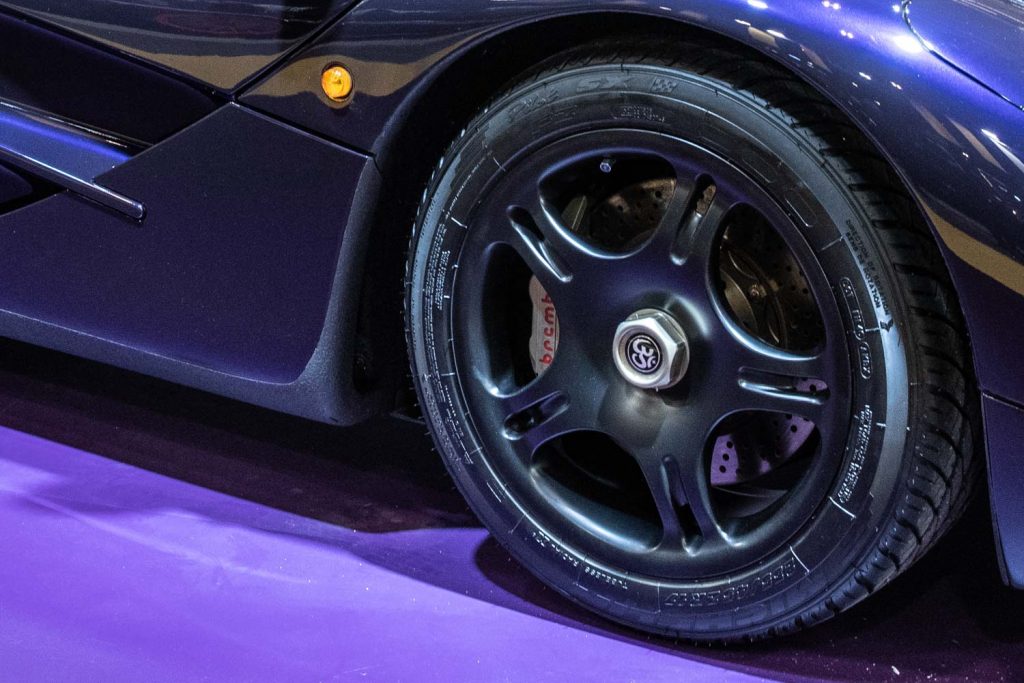
Harrison was an avid follower of Hinduism and had several symbols of this religion incorporated into 025. They are on the wheel covers, in the carbon chassis, are incorporated in the seat covers and if you want to honk the horn, you have to press the Hindu symbol on the steering wheel.
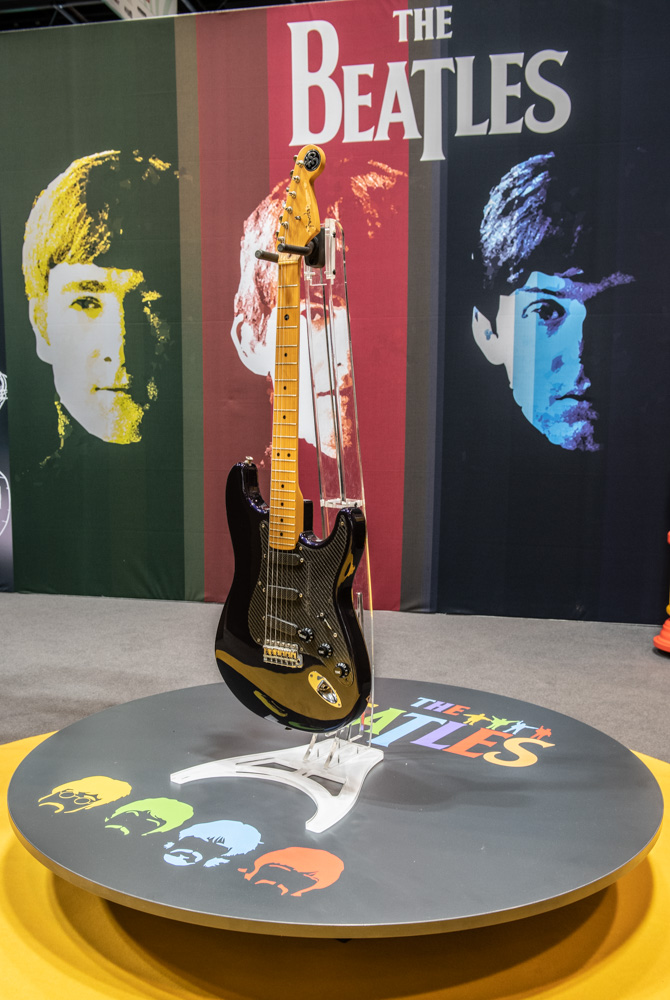
Harrison also has a custom-made guitar and amplifier that can be transported in the F1. We also found these two items next to 025. This F1, with number plate M7 AUM, remains in the possession of the Harrison family after George’s death in 2001. After 20 years, 025 reappears in public for the first time at Rétromobile Paris. The value of this F1 is estimated at $30 million.
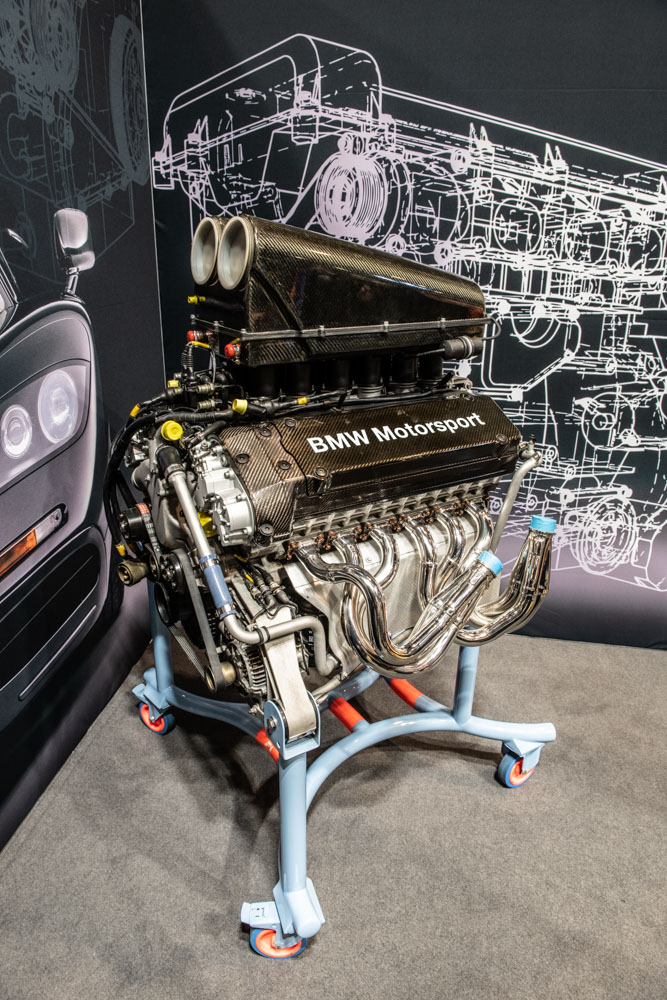
Besides the seven F1s, Kidston had also provided an area where various, Mclaren F1-related items were displayed. Very diverse and very beautiful. It looked a bit like Ali Baba’s cave. In this treasure trove, we found a complete BMW M V12 engine, a real masterpiece by Paul Rosche. This was a spare power unit of the Gulf 025R.
Also present was Facom’s toolbox that came standard with every F1. Apart from all the necessary tools, it also contains a modem that allows the customer to have the F1 communicate with the Mclaren factory in Woking from anywhere in the world. Today this is completely normal, but in 1992 this was very advanced technology.
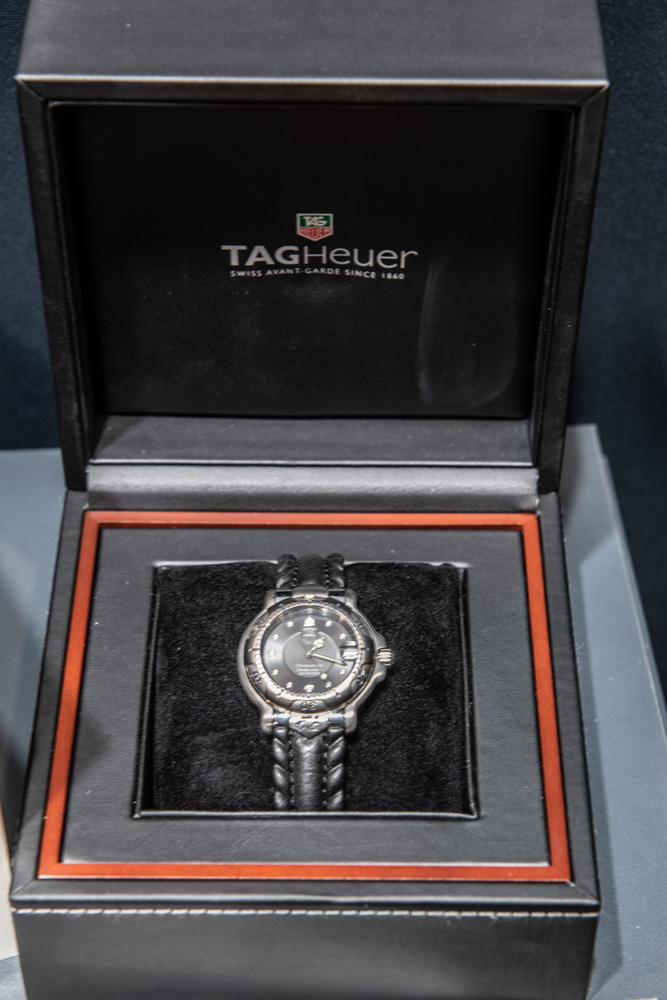
Each F1 also came with, as standard equipment, a TAG Heuer timepiece specially designed for it. This timepiece was also present in one of the display cases.
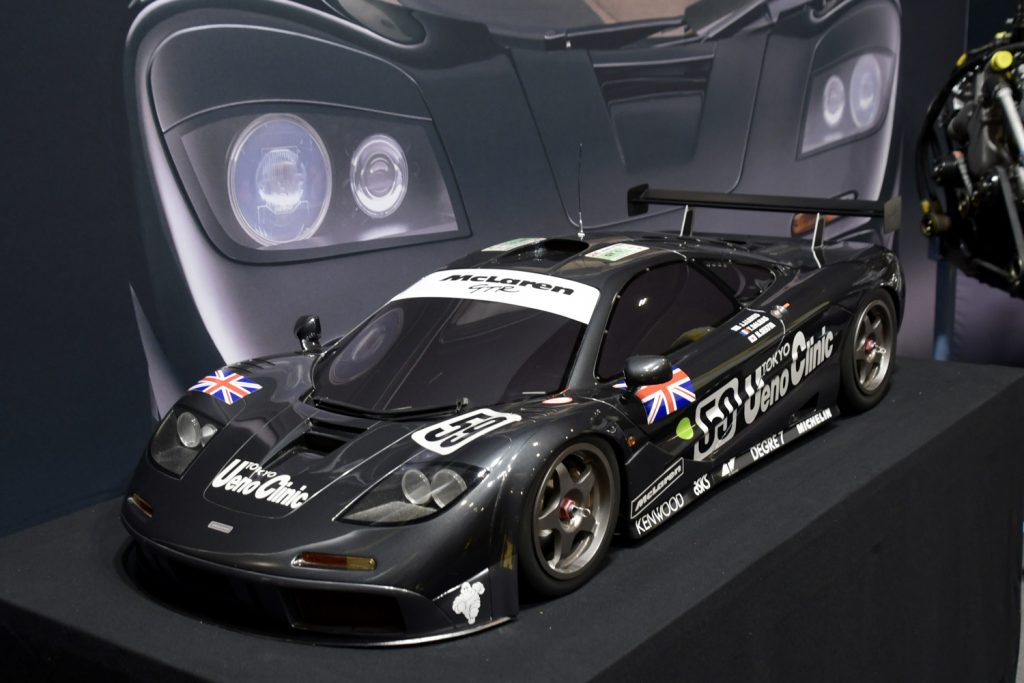
Besides a number of miniature models, we also encountered a wind tunnel model of the F1 GTR in the version of the Le Mans winning 1995 GTR.
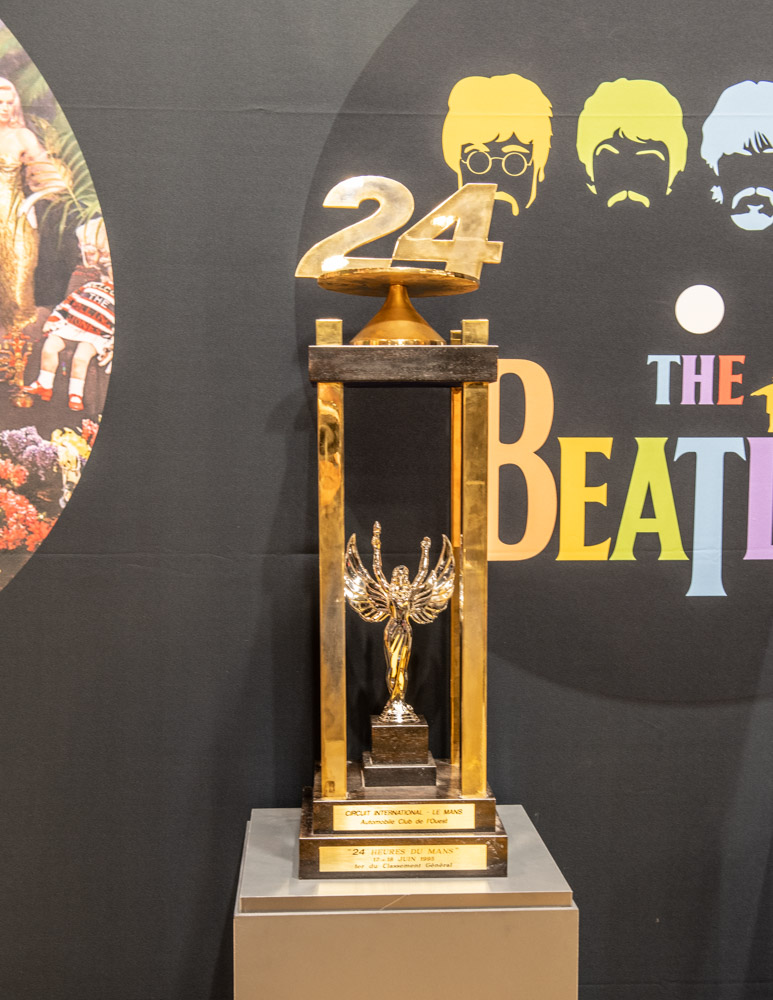
And speaking of Le Mans, the original trophy for the winning constructor had also been specially brought over from the factory in Woking.
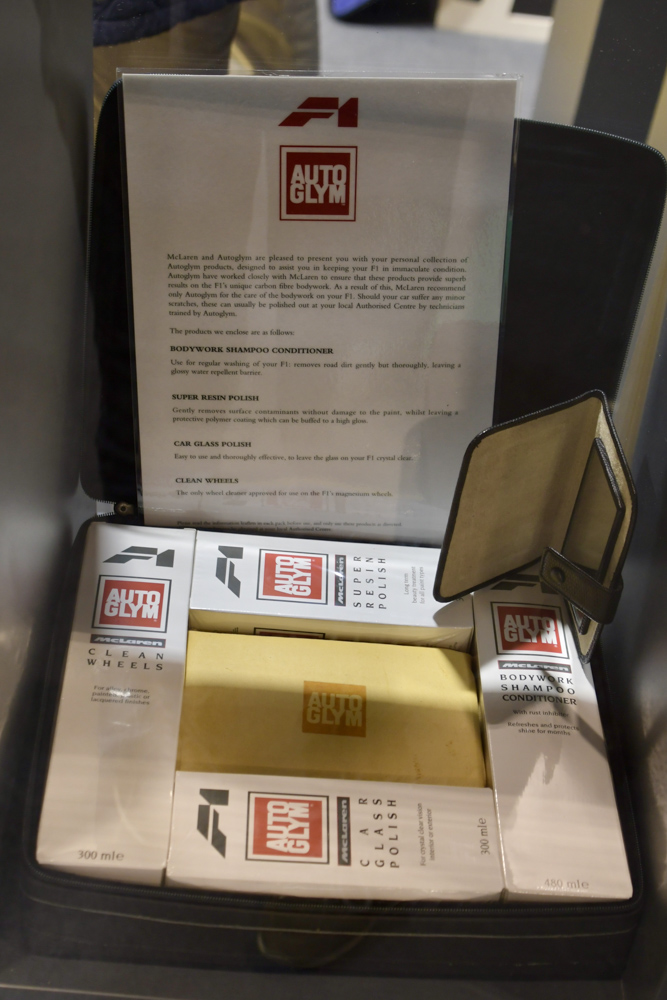
And nothing had been forgotten. We even found Autoglym’s standard included package of cleaning products, still unused, in its original packaging bearing Mclaren’s F1 logo. This contained a chamois sheet, shampoo, rim cleaner and polish.
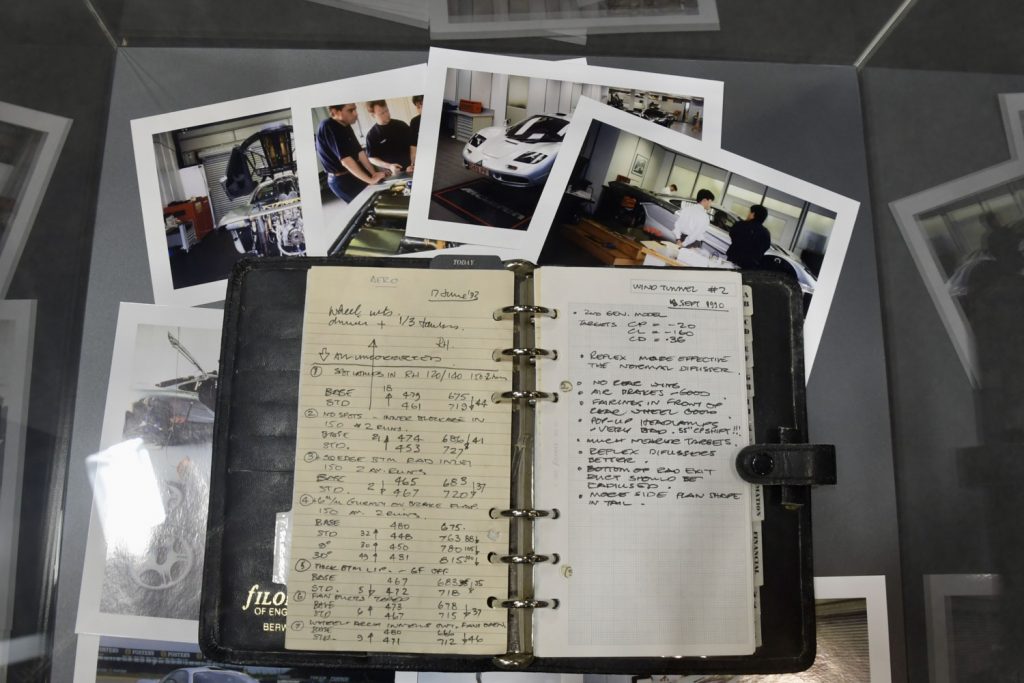
Another masterpiece in this exhibition: two original booklets in which Gordon Murray recorded his notes and sketches for F1. You have to judge for yourself because this is pure art. Using these booklets, the plans were then later drawn out and further elaborated on his drawing board.
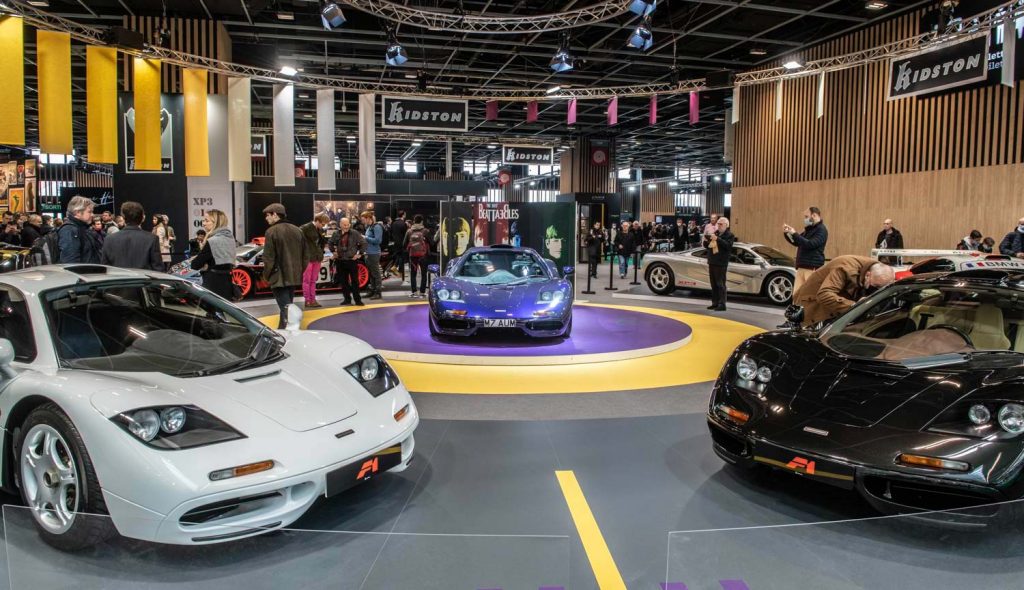
The Mclaren expo had not been announced in advance by Rétromobile’s organisers. So the surprise was very big and very pleasant. Organising such an expo is certainly a feat. The logistics alone are quite an undertaking and how can you convince your insurance company to cover this risk? Fortunately, Kidston got everything sorted out and the tradition of Mclaren’s at Rétromobile, started by Richard Mille, was at least extended by one year after all!
